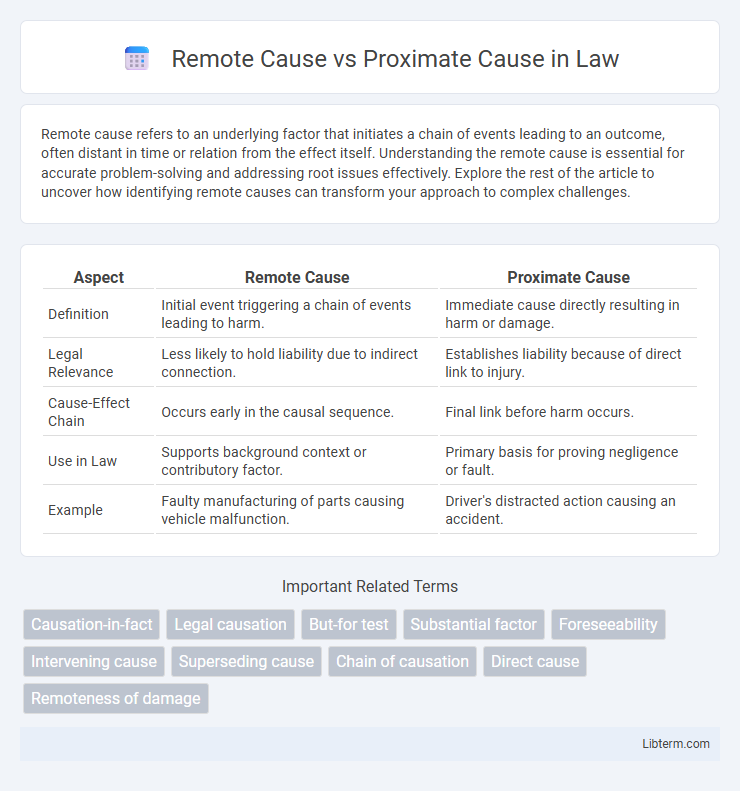Remote cause refers to an underlying factor that initiates a chain of events leading to an outcome, often distant in time or relation from the effect itself. Understanding the remote cause is essential for accurate problem-solving and addressing root issues effectively. Explore the rest of the article to uncover how identifying remote causes can transform your approach to complex challenges.
Table of Comparison
| Aspect | Remote Cause | Proximate Cause |
|---|---|---|
| Definition | Initial event triggering a chain of events leading to harm. | Immediate cause directly resulting in harm or damage. |
| Legal Relevance | Less likely to hold liability due to indirect connection. | Establishes liability because of direct link to injury. |
| Cause-Effect Chain | Occurs early in the causal sequence. | Final link before harm occurs. |
| Use in Law | Supports background context or contributory factor. | Primary basis for proving negligence or fault. |
| Example | Faulty manufacturing of parts causing vehicle malfunction. | Driver's distracted action causing an accident. |
Understanding Remote and Proximate Cause
Understanding remote and proximate cause is crucial in legal and analytical contexts to determine liability and consequences. Proximate cause refers to the immediate, direct event leading to an outcome, while remote cause involves actions or conditions that are indirectly related or further removed in the sequence of events. Distinguishing between them helps establish causal links and foreseeability in damage or injury claims.
Definition of Remote Cause
Remote cause refers to an initial or underlying factor in a chain of events that indirectly leads to an outcome, often separated by intervening causes. It is distinguished from proximate cause, which is the primary or immediate cause directly responsible for the effect. Understanding remote cause is crucial in legal and insurance contexts to determine liability and causation beyond the nearest cause.
Definition of Proximate Cause
Proximate cause is a legal concept that defines the primary cause of an injury or damage, establishing a direct link between an action and its resulting harm. It limits liability to consequences that are reasonably foreseeable and closely connected to the negligent act. Distinct from remote cause, proximate cause ensures accountability is not extended to distant, indirect effects beyond a foreseeable range.
Key Differences Between Remote and Proximate Cause
Remote cause refers to an initial event in the causal chain that indirectly triggers an outcome, while proximate cause is the immediate event that directly leads to the result. The key difference lies in legal responsibility, as proximate cause is typically recognized as the primary factor for liability, whereas remote cause is too distant or indirect to hold accountable. This distinction is crucial in tort law for determining the scope of damages and attributing fault accurately.
Legal Significance of Proximate Cause
Proximate cause holds critical legal significance as it establishes a direct link between an act and the resulting harm, determining liability in negligence cases. Courts use the principle of proximate cause to limit liability to consequences that are reasonably foreseeable, preventing endless chains of causation. This legal boundary ensures fairness by attributing responsibility only for harms closely connected to the defendant's actions.
The Role of Remote Cause in Legal Cases
Remote cause in legal cases refers to an indirect factor that contributes to an event, but does not immediately trigger the outcome. Courts often distinguish remote causes from proximate causes by assessing foreseeability and directness of the connection to the harm. Understanding the role of remote cause is essential for determining liability boundaries and assigning responsibility in complex tort and negligence claims.
Examples Illustrating Remote and Proximate Cause
A remote cause refers to a cause that sets off a chain of events leading to an outcome but is not directly responsible for the immediate result, such as a car manufacturer designing faulty brakes that eventually cause an accident. Proximate cause, by contrast, is the direct cause of an injury or damage, exemplified by a driver running a red light and striking another vehicle. Legal cases often differentiate these causes to determine liability, with proximate cause bearing a more immediate and direct link to the harm experienced.
Tests for Determining Proximate Cause
Tests for determining proximate cause primarily include the foreseeability test, which assesses whether the harm was a predictable result of the defendant's action, and the direct causation test, which examines if the injury followed directly from the act without intervention by a superseding event. The substantial factor test also plays a key role by identifying if the defendant's conduct was a significant contributor to the harm, regardless of other causes. Courts apply these tests to limit liability to consequences closely connected to the defendant's conduct, distinguishing proximate cause from remote cause based on legal responsibility.
Common Misconceptions About Causation
Remote cause often refers to an initial factor in a causal chain that is too distant to be legally or practically responsible for an outcome, whereas proximate cause identifies the immediate cause directly leading to the event. Common misconceptions about causation include confusing correlation with causation and assuming all contributing factors hold equal liability. Understanding the difference between remote and proximate cause is essential in legal contexts, insurance claims, and accident analysis to accurately assign responsibility and avoid oversimplification.
Importance of Causation in Law and Insurance
Causation in law and insurance hinges on distinguishing remote cause from proximate cause to determine liability and claims validity. Proximate cause, as the direct and immediate cause of an event, establishes legal responsibility and eligibility for compensation, while remote cause involves more indirect, less foreseeable factors. Accurate identification of proximate cause is crucial for insurers and courts to allocate risk, assess damages, and prevent unjust claims.
Remote Cause Infographic

 libterm.com
libterm.com